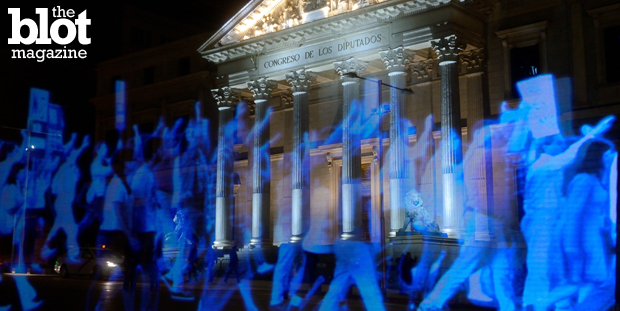
Last week, thousands protested a law they believe limits their civil liberties, but in an ironic twist, nobody had to get off the couch to march through the streets of Madrid. Though Spain may be internationally known for the siesta, its capital city made headlines for being filled with hologram images of marchers and speakers decrying a new law that can fine individuals for speaking out and rallying in front of government buildings.

If the first-ever tech-based hologram protest held in front of the country’s lower house of parliament projected through webcams could become a way to organize people politically, it might bring with it a golden age of political activism. Long heralded for its democratizing effects, the Internet has failed more than succeeded in spurring actual physical action. From the images of “The Simpsons” Comic Book Guy fat slob character excoriating his favorite television show as the “worst episode ever” to just encouraging plain old laziness, hologram protests could hopefully provide a forum for increased political expression and social activism.
And it would certainly bring more power into the hands of the people.
The governing Popular Party passed the law; its text was published in March, and it is scheduled to go into effect in July. Even the name of the measure — termed the “Citizen Safety Law” — is more than a little terrifyingly Orwellian. Not only is the law an affront to civil liberties including speech and assembly, it is just a plain bad idea, and the best that could come of such a half-cooked measure is people reacting in disbelief or by simply disobeying.
If the response became a way for young people or those who are expert with emerging technologies (not that the webcam is very new) to express their ideas or a way for diverse groups to coalesce around a common issue, that would be the best that could come of it. The hologram protest already brought people together around a common cause actually. The images of people protesting were not just of Spanish citizens directly affected by the gag order-like law, but from volunteers around the world as the campaign asked for submissions to add to the webcam projections. People were encouraged to appear as if they were on the street at the rally by recording themselves through a webcam and sending the images to protest organizers through the campaign’s website.
Obviously, governments of many types and incarnations have attempted to limit freedom though various means since the invention of organized human societies. I’m hoping this is a sign that a 1960s-era golden age of political engagement is the end result of this anti-democratic law.
What is certain is that when holograms are on the street, this is no longer your parents’ protest.
Noah Zuss is a reporter for TheBlot Magazine.





